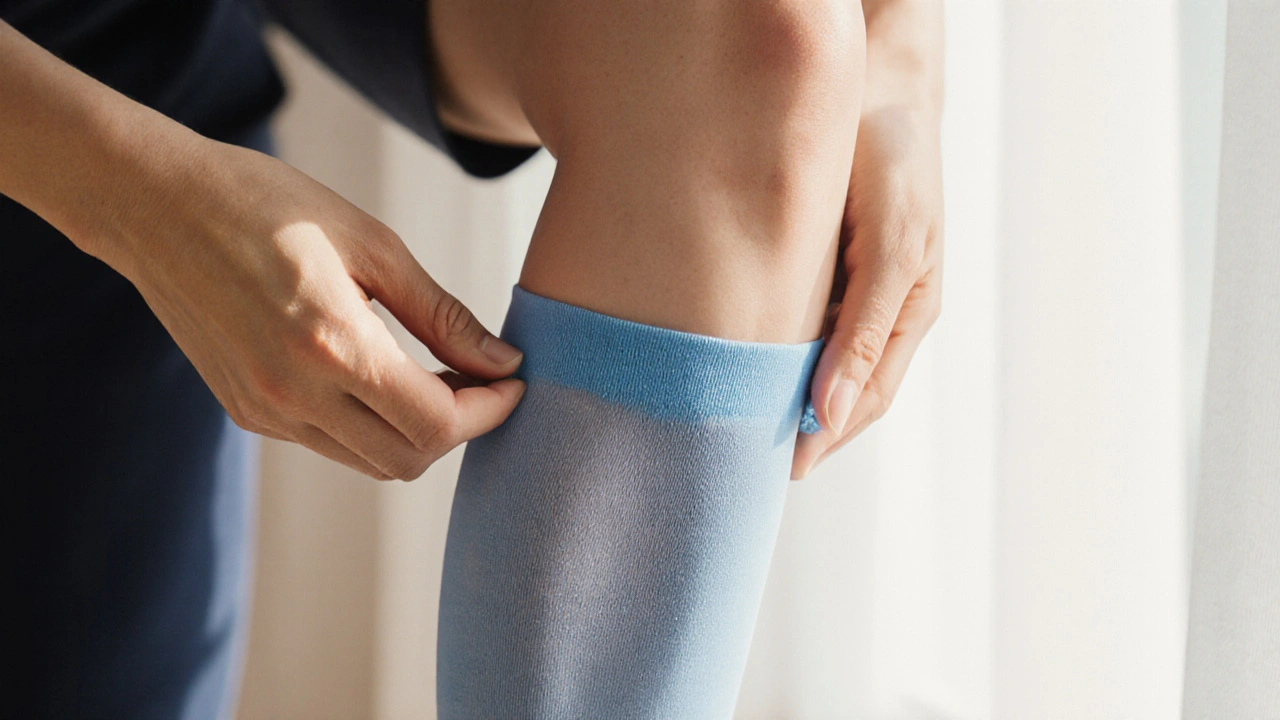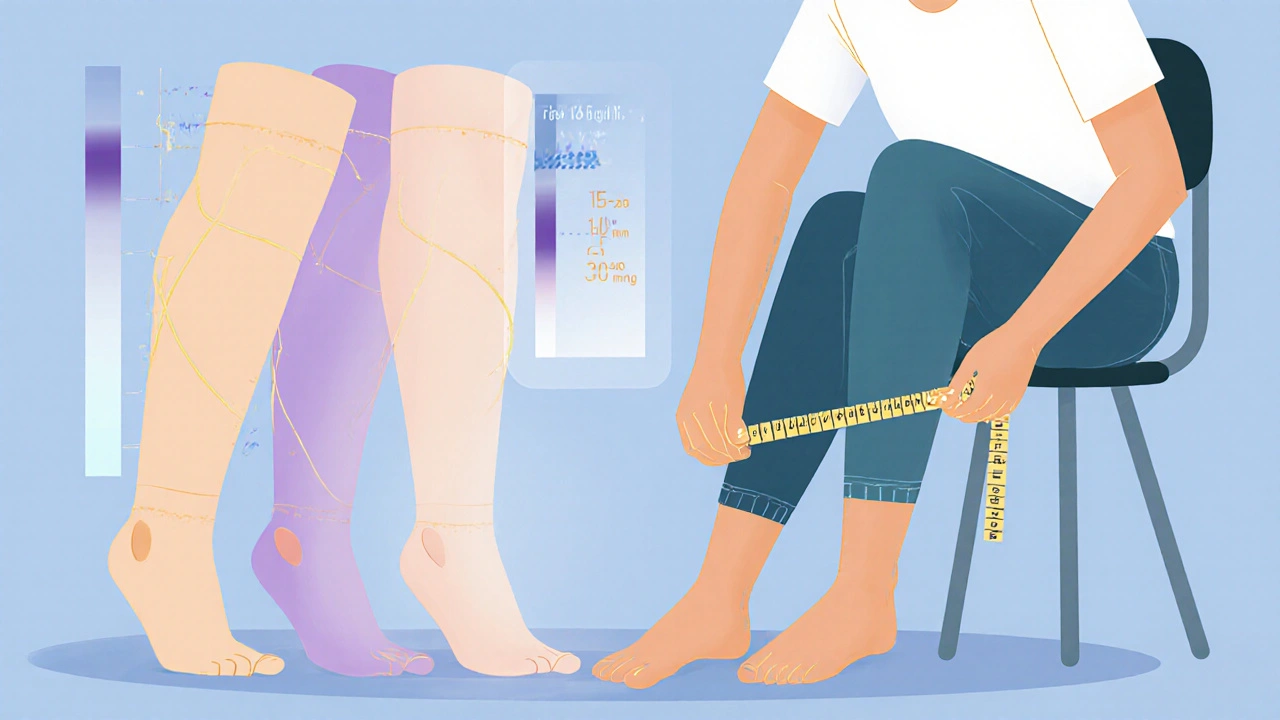
Compression Stockings Selector
Recommended Compression Stockings
When fluid builds up in the legs, finding the right compression stockings can mean the difference between constant discomfort and genuine relief. This guide walks you through the most important factors-pressure class, length, material, and fit-so you can pick a pair that actually eases your oedema without causing new problems.
Key Takeaways
- Understand the pressure classes (mmHg) and match them to your swelling level.
- Measure both length and circumference accurately; a proper fit is essential.
- Choose the right garment length (knee‑high, thigh‑high, or pantyhose) based on where swelling occurs.
- Pick breathable fabrics if you have skin sensitivities.
- Follow wearing and care tips to maximise therapeutic benefit.
What Is Oedema and Why Compression Helps
Oedema the accumulation of excess fluid in the body's tissues, often seen in the lower limbs can result from anything that hinders venous return-prolonged standing, pregnancy, heart failure, or chronic venous insufficiency. The extra fluid stretches the skin and can cause pain, reduced mobility, and even skin breakdown. By applying gentle, graduated pressure, Compression Stockings elastic garments designed to apply graduated pressure to the legs, helping fluid move upward and reduce swelling compress the superficial veins, improve lymphatic flow, and support the calf muscle pump.
How Graduated Compression Works
Not all compression is equal. Graduated Compression a pressure gradient that is highest at the ankle and decreases toward the thigh mimics the natural pressure gradient of healthy circulation. This design encourages blood and lymph to travel back toward the heart, preventing fluid from pooling in the ankle and lower calf. The pressure is measured in mmHg millimeters of mercury, the standard unit for measuring compression pressure, and typical classes range from 15‑20mmHg (light) to 40‑50mmHg (very firm).
Types of Compression Stockings
Choosing the right length is a matter of where your swelling lives.
- Knee‑high Stockings stockings that stop just below the knee, ideal for localized swelling are perfect when oedema is confined to the lower calf and ankle.
- Thigh‑high Stockings stockings that extend up to the upper thigh, covering a larger area work better for swelling that reaches the mid‑calf or when you need continuous support throughout the leg.
- Compression Pantyhose full‑leg garments that provide uniform pressure from foot to waist are suited for women who want both therapeutic compression and a smoother appearance under clothing.

Pressure Levels and When to Use Them
Below is a quick reference that pairs pressure class with typical clinical scenarios.
| Pressure (mmHg) | Typical Use | Suitable Conditions |
|---|---|---|
| 15‑20 | Prevention & mild swelling | Travel, standing jobs |
| 20‑30 | Moderate oedema | Post‑surgical, varicose veins |
| 30‑40 | Severe oedema | Lymphedema, deep vein thrombosis (after doctor approval) |
| 40‑50 | Very severe cases | Physician‑prescribed chronic conditions |
How to Measure for a Perfect Fit
Even the most sophisticated garment won’t work if the size is off. Follow these steps:
- Sit on a firm chair with feet flat on the floor.
- Measure the circumference of your ankle (just above the malleolus) using a flexible tape measure.
- Measure the widest part of your calf (mid‑calf) and, if you need thigh‑high stockings, the circumference of the thigh (about 10cm above the patella).
- Measure the length from the floor to the back of the knee for knee‑highs, or to the top of the thigh for thigh‑highs. For pantyhose, measure from the floor to the waist.
- Consult the manufacturer’s size chart-most brands list ranges in centimeters or inches. If you fall between two sizes, choose the larger for comfort.
Remember, a snug but not painful fit is the goal; the fabric should feel like a firm hug, not a tight band.
Material Matters: Breathability, Durability, and Skin Sensitivity
Most modern Compression Stockings elastic garments designed to apply graduated pressure to the legs, helping fluid move upward and reduce swelling blend nylon with spandex or Lycra. Nylon offers strength and elasticity, while spandex provides stretch. If you have eczema or diabetes, look for stockings labeled “hypoallergenic” or “moisture‑wicking” to reduce skin irritation. Some premium lines incorporate copper‑infused yarns that claim antimicrobial benefits, though evidence is limited.
Putting Them On: Practical Tips
- Wear the stockings in the morning before swelling starts; this maximises the therapeutic effect.
- Roll the stocking down to the toe, then gently pull it up, smoothing out wrinkles as you go. Avoid bunching, which creates pressure points.
- If you have trouble reaching your feet, use a donning device-usually a plastic hoop that helps slide the toe into place.
- Keep the stockings on for the duration your doctor recommends, typically 8‑12hours per day.
- Remove them before bedtime unless your clinician advises otherwise.
Caring for Your Stockings to Extend Their Life
Improper care degrades elasticity, reducing effectiveness.
- Hand‑wash in lukewarm water with a mild detergent; avoid bleach.
- Do not wring or twist; gently press out excess water.
- Lay flat on a clean towel to dry-never tumble‑dry.
- Inspect weekly for tiny holes or thinning fabric; replace as soon as you notice wear.
Common Mistakes and How to Avoid Them
- Choosing too high a pressure: If the stockings feel painful, they’re likely too firm. Over‑compression can impair circulation.
- Wrong length: Knee‑highs won’t help thigh‑level swelling. Match length to the highest point of oedema.
- Skipping sizing: Buying “one size fits all” often leads to loose fits that don’t apply enough pressure.
- Wearing for too long: Extended wear can cause skin maceration. Follow a schedule and watch for redness or itching.
When to Seek Professional Advice
If you have underlying conditions such as diabetes, peripheral artery disease, or a history of blood clots, consult a vascular specialist before starting any compression regimen. A professional can prescribe the exact pressure class and ensure there are no contraindications.
Frequently Asked Questions
How often should I replace my compression stockings?
Most experts recommend replacing them every 3‑6months, depending on wear frequency and how well you care for them. Look for signs of thinning, loss of elasticity, or visible damage.
Can I wear compression stockings while exercising?
Yes, especially the 15‑20mmHg range, which can improve circulation during low‑impact activities. For high‑intensity workouts, choose a lighter class to avoid excessive pressure.
Are there any fabrics I should avoid if I have sensitive skin?
Avoid pure latex or oil‑based elastics, which can trigger irritation. Look for nylon‑spandex blends labeled “hypoallergenic” or those with moisture‑wicking technology.
What if my ankle measurement changes throughout the day?
Measure in the morning when swelling is minimal. If you notice a large increase later, consider a slightly larger size or a lower pressure class to maintain comfort.
Can I wear compression stockings on hot days?
Yes, but choose breathable, moisture‑wicking fabrics and avoid tight fits that trap heat. Take them off for short breaks if you feel overheating.
6 Comments
Write a comment
More Articles

Diovan Uses, Side Effects & Real-World Patient Tips for Better Blood Pressure Control
Diovan is a widely prescribed medicine for controlling high blood pressure. This article uncovers how Diovan (valsartan) works, its real impact on heart and kidney health, and what to watch for in daily life. Expect useful tips, guidance, and actual numbers from clinical research. Whether you’re considering Diovan or managing your dose, this read explains what other guides leave out.


Jeffery Reynolds
October 7, 2025 AT 18:49While the guide is thorough, there are a few grammatical missteps that need correction. The phrase “fluid builds up” should be followed by a comma when introducing a clause. Also, “compression stockings elastic garments” is redundant; choose either “compression stockings” or “elastic garments.” Finally, ensure consistent use of the Oxford comma in the list of benefits.